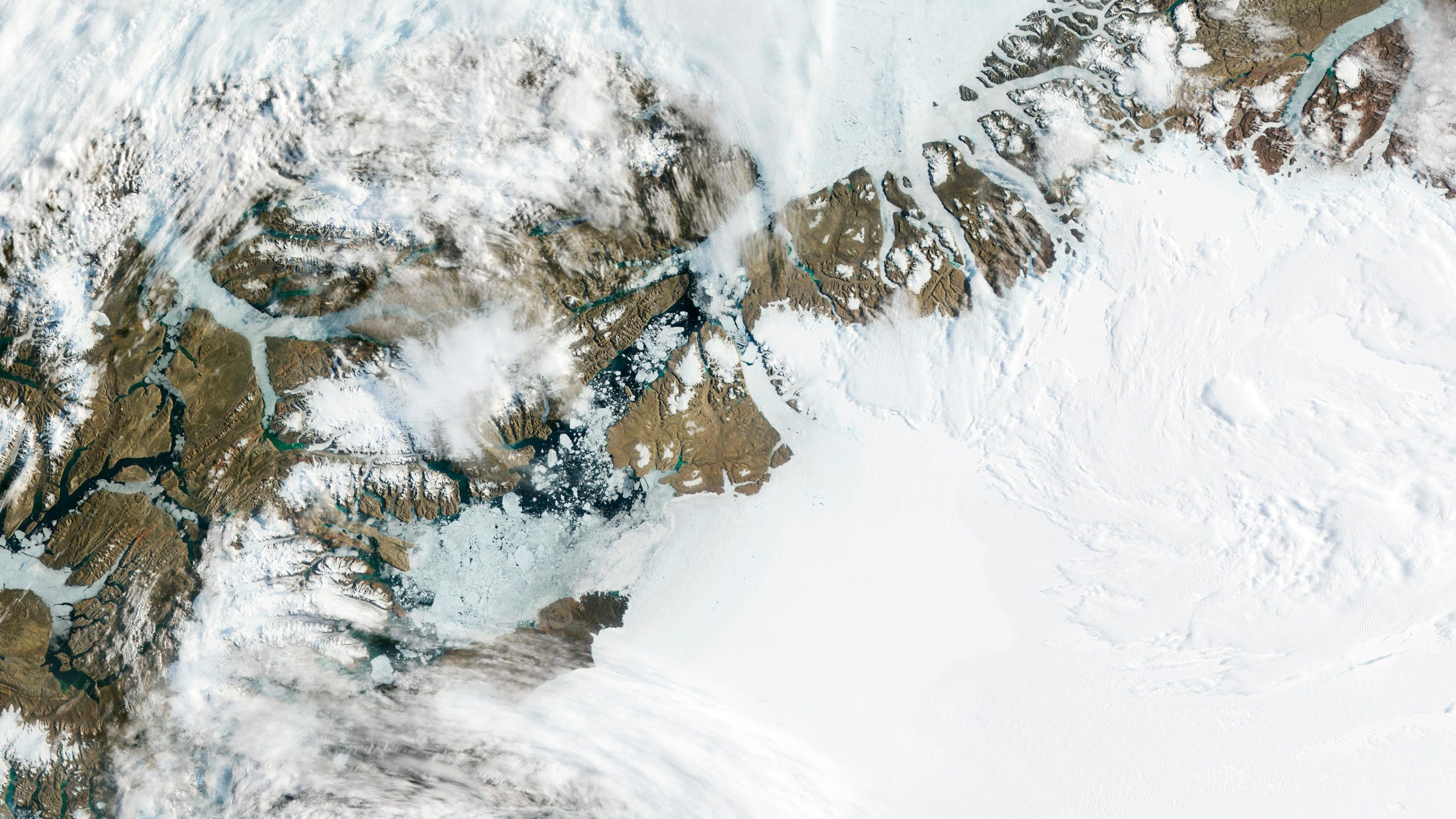
In der Mitte dieses von der NASA 2012 aufgenommenen Bildes bewegt sich der Petermann-Gletscher im Nordwesten Grönlands allmählich in Richtung Ozean, wobei große Teile abbrechen und als Eisberge davontreiben. Forscher von UCI und NASA JPL nutzten Satellitendaten von drei europäischen Missionen, um zu sehen, wie warmes Meerwasser dazu führt, dass die Grundlinie des Gletschers wandert, was zu seinem raschen Rückgang führt. Bildnachweis: NASA
Die Studie legt nahe, dass das Ausmaß des künftigen Meeresspiegelanstiegs stark unterschätzt werden könnte.
Neue Forschungsergebnisse zeigen, dass sich die Basislinie des grönländischen Petermann-Gletschers während der Gezeitenzyklen verschiebt, wodurch warmes Meerwasser die Eisschmelze beschleunigt. Diese bisher unbekannte Wechselwirkung könnte dazu führen, dass die Prognosen für den Anstieg des Meeresspiegels für Gletscher, die den Ozean abschließen, um 200 % ansteigen, wenn sie in die Modelle einbezogen werden.
Bei einer Studie am Petermann-Gletscher im Nordwesten Grönlands entdeckten Forscher der University of California, Irvine und des Jet Propulsion Laboratory der NASA eine bisher unbekannte Art und Weise, wie Eis und Ozean interagieren. Die Glaziologen sagten, ihre Ergebnisse könnten bedeuten, dass die Klimagemeinschaft den künftigen Anstieg des Meeresspiegels aufgrund der Verschlechterung des Polareises stark unterschätzt habe.
Unter Verwendung von Satellitenradardaten von drei europäischen Missionen hat UCI/[{“ attribute=““>NASA team learned that Petermann Glacier’s grounding line – where ice detaches from the land bed and begins floating in the ocean – shifts substantially during tidal cycles, allowing warm seawater to intrude and melt ice at an accelerated rate. The group’s results are the subject of a paper published on May 8 in Proceedings of the National Academy of Sciences.
“Petermann’s grounding line could be more accurately described as a grounding zone, because it migrates between 2 and 6 kilometers as tides come in and out,” said lead author Enrico Ciraci, UCI assistant specialist in Earth system science and NASA postdoctoral fellow. “This is an order of magnitude larger than expected for grounding lines on a rigid bed.”
He said the traditional view of grounding lines beneath ocean-reaching glaciers was that they did not migrate during tidal cycles, nor did they experience ice melt. But the new study replaces that thinking with knowledge that warm ocean water intrudes beneath the ice through preexisting subglacial channels, with the highest melt rates occurring at the grounding zone.
The researchers found that as Petermann Glacier’s grounding line retreated nearly 4 kilometers – 2½ miles – between 2016 and 2022, warm water carved a 670-foot-tall cavity in the underside of the glacier, and that abscess remained there for all of 2022.
“These ice-ocean interactions make the glaciers more sensitive to ocean warming,” said senior co-author Eric Rignot, UCI professor of Earth system science and NASA JPL research scientist. “These dynamics are not included in models, and if we were to include them, it would increase projections of sea level rise by up to 200 percent – not just for Petermann but for all glaciers ending in the ocean, which is most of northern Greenland and all of Antarctica.”
The Greenland ice sheet has lost billions of tons of ice to the ocean in the past few decades, the PNAS paper stresses, with most of the loss caused by warming of subsurface ocean waters, a product of Earth’s changing climate. Exposure to ocean water melts the ice vigorously at the glacier front and erodes resistance to the movement of glaciers over the ground, causing the ice to slide more quickly to the sea, according to Rignot.
Reference: “Melt rates in the kilometer-size grounding zone of Petermann Glacier, Greenland, before and during a retreat” by Enrico Ciracì, Eric Rignot, Bernd Scheuchl, Valentyn Tolpekin, Michael Wollersheim, Lu An, Pietro Milillo, Jose-Luis Bueso-Bello, Paola Rizzoli and Luigi Dini, 8 May 2023, Proceedings of the National Academy of Sciences.
DOI: 10.1073/pnas.2220924120
Ciraci’s research was supported by the NASA Postdoctoral Program at the Jet Propulsion Laboratory. Joining Ciraci and Rignot on the project were Bernd Scheuchl, UCI associate project scientist; Valentyn Tolpekin and Michael Wollersheim of Finland’s Iceye mission; Lu An of China’s Tongji University; Pietro Milillo of the University of Houston; Jose-Luis Bueso-Bello of the German Aerospace Center; and Luigi Dini of the Italian Space Agency.

„Pop-Kulturaholic. Web-Nerd. Engagierter Social-Media-Praktiker. Reisefanatiker. Schöpfer. Food-Guru.“

/cdn.vox-cdn.com/uploads/chorus_asset/file/24924650/236780_Google_AntiTrust_Trial_Custom_Art_CVirginia__0000_4.png)




More Stories
Die Federal Aviation Administration fordert eine Untersuchung des Misserfolgs bei der Landung der Falcon-9-Rakete von SpaceX
Identische Dinosaurier-Fußabdrücke auf zwei Kontinenten entdeckt
SpaceX startet 21 Starlink-Satelliten mit einer Falcon 9-Rakete von Cape Canaveral aus – SpaceflightNow